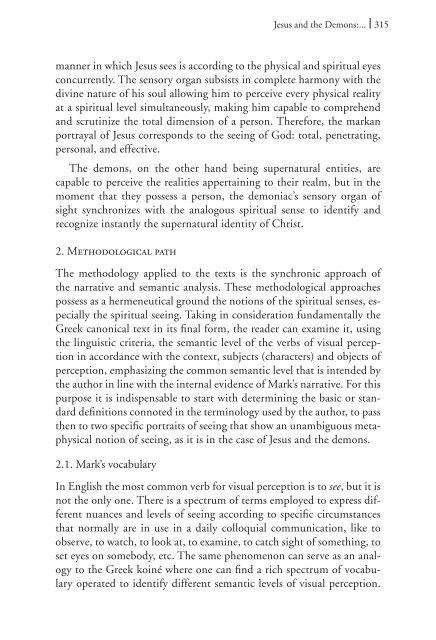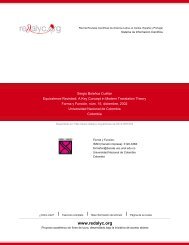Portraits of the spiritual Seeing in Mark's Gospel. Origen ... - Redalyc
Portraits of the spiritual Seeing in Mark's Gospel. Origen ... - Redalyc
Portraits of the spiritual Seeing in Mark's Gospel. Origen ... - Redalyc
Create successful ePaper yourself
Turn your PDF publications into a flip-book with our unique Google optimized e-Paper software.
Jesus and <strong>the</strong> Demons:...<br />
315<br />
manner <strong>in</strong> which Jesus sees is accord<strong>in</strong>g to <strong>the</strong> physical and <strong>spiritual</strong> eyes<br />
concurrently. The sensory organ subsists <strong>in</strong> complete harmony with <strong>the</strong><br />
div<strong>in</strong>e nature <strong>of</strong> his soul allow<strong>in</strong>g him to perceive every physical reality<br />
at a <strong>spiritual</strong> level simultaneously, mak<strong>in</strong>g him capable to comprehend<br />
and scrut<strong>in</strong>ize <strong>the</strong> total dimension <strong>of</strong> a person. Therefore, <strong>the</strong> markan<br />
portrayal <strong>of</strong> Jesus corresponds to <strong>the</strong> see<strong>in</strong>g <strong>of</strong> God: total, penetrat<strong>in</strong>g,<br />
personal, and effective.<br />
The demons, on <strong>the</strong> o<strong>the</strong>r hand be<strong>in</strong>g supernatural entities, are<br />
capable to perceive <strong>the</strong> realities apperta<strong>in</strong><strong>in</strong>g to <strong>the</strong>ir realm, but <strong>in</strong> <strong>the</strong><br />
moment that <strong>the</strong>y possess a person, <strong>the</strong> demoniac’s sensory organ <strong>of</strong><br />
sight synchronizes with <strong>the</strong> analogous <strong>spiritual</strong> sense to identify and<br />
recognize <strong>in</strong>stantly <strong>the</strong> supernatural identity <strong>of</strong> Christ.<br />
2. Methodological path<br />
The methodology applied to <strong>the</strong> texts is <strong>the</strong> synchronic approach <strong>of</strong><br />
<strong>the</strong> narrative and semantic analysis. These methodological approaches<br />
possess as a hermeneutical ground <strong>the</strong> notions <strong>of</strong> <strong>the</strong> <strong>spiritual</strong> senses, especially<br />
<strong>the</strong> <strong>spiritual</strong> see<strong>in</strong>g. Tak<strong>in</strong>g <strong>in</strong> consideration fundamentally <strong>the</strong><br />
Greek canonical text <strong>in</strong> its f<strong>in</strong>al form, <strong>the</strong> reader can exam<strong>in</strong>e it, us<strong>in</strong>g<br />
<strong>the</strong> l<strong>in</strong>guistic criteria, <strong>the</strong> semantic level <strong>of</strong> <strong>the</strong> verbs <strong>of</strong> visual perception<br />
<strong>in</strong> accordance with <strong>the</strong> context, subjects (characters) and objects <strong>of</strong><br />
perception, emphasiz<strong>in</strong>g <strong>the</strong> common semantic level that is <strong>in</strong>tended by<br />
<strong>the</strong> author <strong>in</strong> l<strong>in</strong>e with <strong>the</strong> <strong>in</strong>ternal evidence <strong>of</strong> Mark’s narrative. For this<br />
purpose it is <strong>in</strong>dispensable to start with determ<strong>in</strong><strong>in</strong>g <strong>the</strong> basic or standard<br />
def<strong>in</strong>itions connoted <strong>in</strong> <strong>the</strong> term<strong>in</strong>ology used by <strong>the</strong> author, to pass<br />
<strong>the</strong>n to two specific portraits <strong>of</strong> see<strong>in</strong>g that show an unambiguous metaphysical<br />
notion <strong>of</strong> see<strong>in</strong>g, as it is <strong>in</strong> <strong>the</strong> case <strong>of</strong> Jesus and <strong>the</strong> demons.<br />
2.1. Mark’s vocabulary<br />
In English <strong>the</strong> most common verb for visual perception is to see, but it is<br />
not <strong>the</strong> only one. There is a spectrum <strong>of</strong> terms employed to express different<br />
nuances and levels <strong>of</strong> see<strong>in</strong>g accord<strong>in</strong>g to specific circumstances<br />
that normally are <strong>in</strong> use <strong>in</strong> a daily colloquial communication, like to<br />
observe, to watch, to look at, to exam<strong>in</strong>e, to catch sight <strong>of</strong> someth<strong>in</strong>g, to<br />
set eyes on somebody, etc. The same phenomenon can serve as an analogy<br />
to <strong>the</strong> Greek ko<strong>in</strong>é where one can f<strong>in</strong>d a rich spectrum <strong>of</strong> vocabulary<br />
operated to identify different semantic levels <strong>of</strong> visual perception.
















